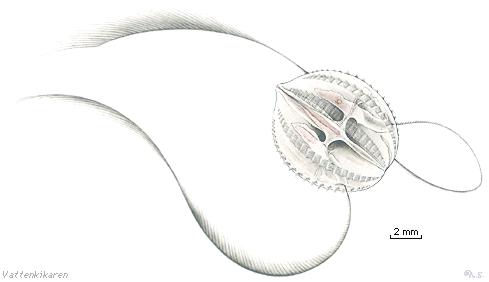 |
 |

 Distribution in scandinavian waters |
Maximum length: 2,5 cm with the exception
of the tentacles. Appearance: Sea-gooseberries are completely transparent, while the pharynx and the tentacles are light white, yellow or orange. On the exterior of the almost spherical body eight comb-rows are situated, which can shimmer with all the colours of the rainbow. Sea-gooseberries have two long and branchy tentacles which they trail after themselves through the water. Compare with comb jellies and Bolinopsis infundibulum. Depth: From the surface to unknown depth. Environment: Pelagic. Misc: Sea-gooseberries can easily be mistaken for in the Arctic more widespread Mertensia ovum. Adult individuals of this species are longer and slimer and can be up to 5,5 cm long. When the sea-gooseberry glides through the water it drags its sticky, but non-poisonous tentacles after itself. In this way, it catches animal plankton, for example Calanoida copepods. Certain fish, i.e. lump suckers, and Bolinopsis infundibulum och other comb jellies feed on sea-gooseberries. Individual adults produce eggs and sperm that they release into the water and where fertilization takes place. Sea-gooseberries shimmer in the dark. Classification: Sea-gooseberries are members the comb jelly group (ctenophora). |